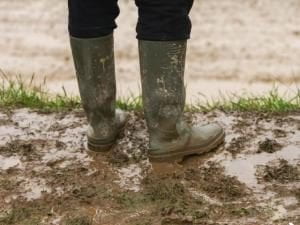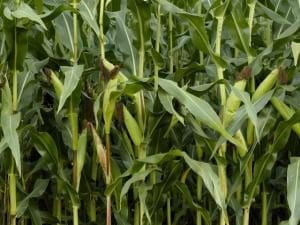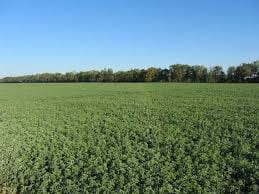Good evening,
Even though there has not been much field work lately, farmers have been busy thinking about what to do with their fields that are unplanted. Much thought goes into a decision about unplanted acres and the options for those fields, along with the crop insurance decisions that come with prevented planting. I submitted an article to the media last week about this topic and have included it with this email. As I write this edition of the Hardin County Agriculture and Natural Resources Update, today marks the end of the late planting period for corn. Some additional corn will be planted, mostly to be chopped for silage as needed for dairy cattle. Even so, it will be pushing the limit for quality silage but when it is needed for feed, it will need to be planted. Now that June 20 has passed, we have several fields in the county that will be claimed for prevented planting for soybeans. These fields, along with the prevented planting corn fields have weeds that need to be managed and other decisions to make about cover crops and possible forage harvest. There are several factors that need to be considered and OSU Extension and the Ohio No-Till Council have planned a special meeting with several experts to help answer those questions on Thursday, June 27 from 6:30-9:00 pm at Ohio Northern University Mcintosh Center (402 W College Ave, Ada). We will address weed control, crop insurance, and cover crops for unplanted acres. See the attached news release for this meeting. You won’t want to miss it.
Prevented Planting Decisions News Release
Cover Crops Meeting News Release
The USDA Risk Management Agency announced just the other day that cover crops planted on prevented planting acres can be grazed, chopped, or hayed for livestock beginning September 1. This will help address the lack of forages for livestock producers. See the attached news release from USDA to read more about this change. However, it is important that you discuss this with your crop insurance agent to make sure you are following all rules before deciding to plant cover crops or harvest forages on prevented planting fields. Also, if you have land in NRCS – EQIP or CSP programs, you will need to get any cover crop changes approved by your local NRCS office before you plant. There are guidelines that need to be followed to make sure you remain eligible for these programs. Also, make sure you do the necessary reporting with FSA for crops planted and crops that will be prevented planting. Although the June 24 Ohio Crop Weather Report that I have attached says that 80% of the corn is planted and 65% of the soybeans are planted across Ohio, this is now intended planted acres as of this date. Wheat harvest is just around the corner, so a timely harvest is important to maintain yield and quality. Often times wet weather causes problems with yield, test weight, and grain quality so don’t delay harvesting this crop.
RMA Announces Change to Haying and Grazing Date News Release
June 24 Ohio Crop Weather Report
The Ohio Department of Agriculture has announced that the Ohio Working Lands Buffer Program sign-up period has again been made available as of June 17. This program encourages producers in the Western Lake Erie Basin Watershed to establish year‐round vegetative cover on eligible cropland. The program promotes the conversion, establishment and maintenance of forage/hay land on certain cropland acres. As the name implies “Working Lands Buffers” act as a buffer on cropland and provides another line of defense to filter surface water while allowing participants to harvest forage from established areas. See the attached flyer and stop by the Hardin SWCD office to apply. An annual payment of $120 per acre per year over a 5‐year period is available for establishment and maintenance.
Working Lands Buffer Program Flyer
The Small Grains Program is also available through ODA. It is a voluntary program that encourages producers in the Western Lake Erie Basin Watershed to plant small grains such as wheat, barley, oats or cereal rye on eligible cropland. This program promotes the planting of small grains not only for the conservation benefits, but to provide livestock producers with a longer time period to land apply manure and nutrients. As the “working lands” name implies participants can plant and harvest small grains, land apply manure, and plant a cover crop to receive a cost-share payment of $75 per acre to help offset operating costs. Livestock producers are encouraged to work with neighboring grain farmers that are able to utilize manure as a source of nutrients for their crops. Again, stop by the Hardin SWCD office if you want to apply. See the attached flyer for more details about this program if you are interested. Well, that is a lot of information to digest, but if you want more I have included some ag crops articles below.
Mark
Cover Crops for Prevented Planting Acres at ONU Thursday, June 27 – Mark Badertscher
Do you have questions about what cover crops should be used on Prevented Planting acres? Do you have concerns about weed control for unplanted fields? What are the rules regarding crop insurance and planting forages to be used for grazing, cutting, and haying for livestock? Get these and other questions answered this Thursday, June 27. The Ohio No-Till Council, in cooperation with OSU Extension, will host a meeting at Ohio Northern University Mcintosh Center in Ada. The address is 402 West College Avenue, Ada, Ohio 45810. The meeting will be from 6:30 to 9:00 pm and will be free to attend. Read more about this meeting at https://agcrops.osu.edu/newsletter/corn-newsletter/201919/cover-crops-prevented-planting-acres-onu-thursday-june-27.
How to store treated seed – Anne Dorrance
Let me say upfront that much of the information in this piece is based on a study published (Crop Science 53:1086-1095 in 2013) by Dr. Susan Goggi’s lab and others at Iowa State University, Dept. of Agronomy & Seed Science Center. As a scientist, we store both untreated and treated seed over years, but it is healthy and it is in cool and always dry conditions. But this year we have several issues. The seed raised in 2018, due to the rains through our long drawn out harvest, left a lot to be desired. Last week, we had one day to plant and now we are making decisions on what to do with the seed we purchased that is treated. Treated seed cannot enter the market and must be disposed of through planting, incineration, or burial based on the label. All of these are costly. Finish reading about proper storage of treated seed at https://agcrops.osu.edu/newsletter/corn-newsletter/201918/how-store-treated-seed.
Using Corn as a Cover Crop – Peter Thomison, Ben Brown, Sam Custer, Greg LaBarge, Sarah Noggle, Mark Sulc, Eric Richer, Harold Watters
Based on information from across the Corn Belt, including states where they have more experience with delayed planting of corn (University of Wisconsin – http://wisccorn.blogspot.com/2019/06/B102.html) and Iowa State University – https://crops.extension.iastate.edu/cropnews/2019/05/cover-crop-options-prevented-planting-fields), these are our best recommendations for using corn as a cover crop. Although the yield potential of corn planted in July for grain and silage is very low, corn makes an excellent “emergency” forage when planted in July. Moreover, unlike some other forage crops, Ohio producers know how to grow it. We also are aware of limited seed supply for several alternatives that typically could be used. Farmers should consult with their insurance agent to see if harvesting as forage will affect any current or future insurance payments on prevented plant acres. Read more at https://agcrops.osu.edu/newsletter/corn-newsletter/201919/using-corn-cover-crop.
Forage Shortage and Prevented Planting Acres… think OATS! – Allen Gahler, Stan Smith
Last week, USDA released the declaration that a cover crop planted onto prevented planting acres can now be harvested as a forage after September 1st, rather than the normal date of November 1st, which provides a small glimmer of hope for some livestock producers and those equipped to harvest forages. While Ohio is also experiencing a severe shortage of forages for all classes of livestock, weed control on prevented planting acres is a major concern, and with USDA’s declaration, we can now address both problems in one action – seeding cover crops that will be harvestable as a forage after September 1st. As with everything else this season, however, patience is the key! Although an ideal situation would be cover crops that can be put out immediately and reduce the need for tillage, chopping, or spraying of weeds already present, there are unfortunately not many species of cover crop that will accomplish this and still provide significant tonnage or feed quality as a forage in September. Finish reading this article at https://agcrops.osu.edu/newsletter/corn-newsletter/201919/forage-shortage-and-prevented-planting-acres%E2%80%A6-think-oats.
2019 Challenge: Forage Production Options for Ohio – Mark Sulc, Bill Weiss, Dianne Shoemaker, Sarah Noggle
Across Ohio, farmers are facing challenges unimagined just four months ago. Widespread loss of established alfalfa stands coupled with delayed or impossible planting conditions for other crops leave many farmers, their agronomists and nutritionists wondering what crops can produce reasonable amounts of quality forage yet this year. In addition, frequent and heavy rains are preventing harvest of forages that did survive the winter and are causing further deterioration of those stands. With July 1st just around the corner, Mark Sulc, OSU Extension Forage Agronomist and Bill Weiss, OSU Extension Dairy Nutritionist, help address this forage dilemma. If one is looking for quality and quantity, what are your best options? Read more about forage options at https://agcrops.osu.edu/newsletter/corn-newsletter/201919/2019-challenge-forage-production-options-ohio.
Mark A. Badertscher
Agriculture and Natural Resources Educator
OSU Extension Hardin County
1021 W. Lima Street, Suite 103, Kenton, OH 43326
419-674-2297 Office
hardin.osu.edu



















